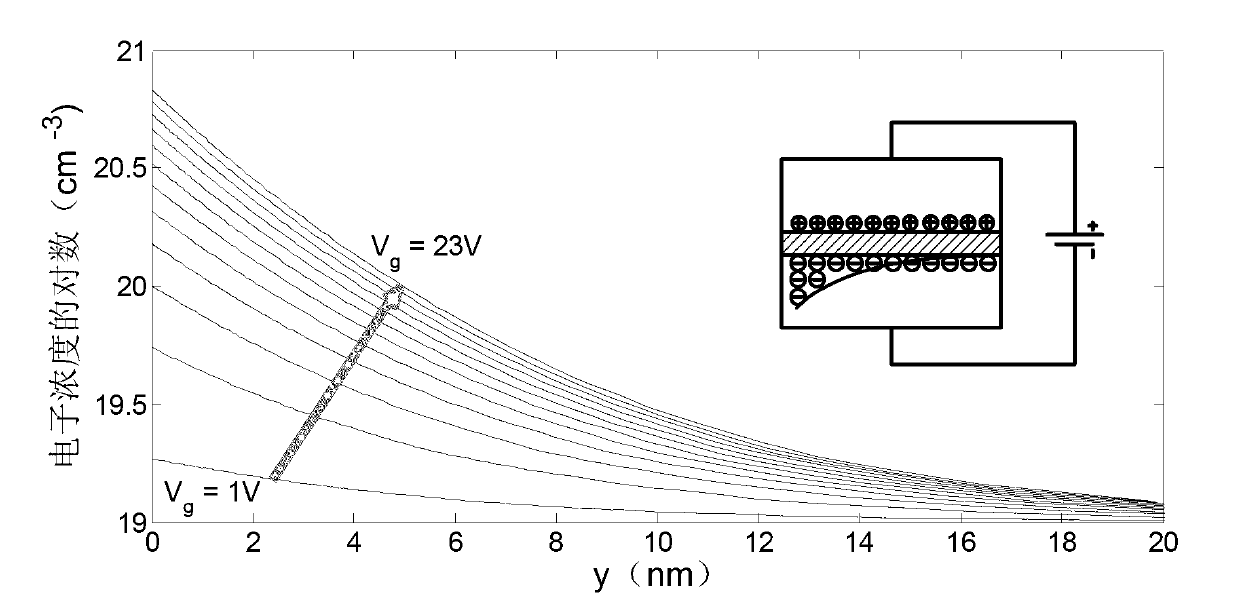Surface plasmon polariton waveguide with metal-insulator-semiconductor (MIS) capacitor structure
A surface plasmon and capacitive structure technology, applied in light guides, optical components, nanotechnology, etc., can solve the problems of unfavorable device integration, reduction of metal layer thickness, and difficulty in compensation, etc., to enhance the local characteristics of the light field and improve The effect of integration and size reduction
- Summary
- Abstract
- Description
- Claims
- Application Information
AI Technical Summary
Problems solved by technology
Method used
Image
Examples
Embodiment 1
[0035] The SPP waveguide of embodiment 1.MIS capacitor structure
[0036] see figure 1 , the SPP waveguide is composed of a metal layer 1 , an insulating material layer 2 , a doped semiconductor layer 3 and a substrate 4 arranged from top to bottom.
[0037] The metal layer 1 can be a silver (Ag) layer.
[0038] The insulating material layer 2 can adopt zirconium dioxide (ZrO 2 )Floor.
[0039] The doped semiconductor layer 3 can use In which is lattice-matched with InP. 0.53 Ga 0.47 As semiconductor layer. The thickness of the doped semiconductor layer should be at least greater than 35nm to ensure that positive and negative ε can appear near the interface of the semiconductor layer r interface.
[0040] The substrate 4 may be an InP substrate.
[0041] The selection of the material and thickness of the insulating material layer has a decisive effect on the realization of the device characteristics. When the dielectric constant of the insulating material is low, the c...
Embodiment 2
[0042] Embodiment 2. is used for the SPP waveguide of the MIS capacitive structure of 1550nm optical communication band (photon energy is about 0.8eV)
[0043] see figure 1 , the SPP waveguide is composed of a metal layer 1, an insulating material layer 2, a doped semiconductor layer 3 and a substrate 4 arranged from top to bottom, wherein:
[0044] The metal layer 1 can be silver (Ag) with a thickness of 100nm.
[0045] The insulating material layer 2 can adopt zirconium dioxide (ZrO2) with a thickness of 10 nm. 2 ).
[0046] The doped semiconductor layer 3 can use In which is lattice-matched with InP. 0.53 Ga 0.47 As, the thickness is 50nm, the doping concentration is 1×10 19 cm -3 , using N-type doping. where In 0.53 Ga 0.47 The selection of As doping concentration takes into account the intrinsic In 0.53 Ga 0.47 As material has the problem of intrinsic absorption in the optical communication window (~0.8eV). In 0.53 Ga 0.47 The direct bandgap of As is 0.74eV,...
PUM
| Property | Measurement | Unit |
|---|---|---|
| Thickness | aaaaa | aaaaa |
| Thickness | aaaaa | aaaaa |
| Thickness | aaaaa | aaaaa |
Abstract
Description
Claims
Application Information
 Login to View More
Login to View More - R&D
- Intellectual Property
- Life Sciences
- Materials
- Tech Scout
- Unparalleled Data Quality
- Higher Quality Content
- 60% Fewer Hallucinations
Browse by: Latest US Patents, China's latest patents, Technical Efficacy Thesaurus, Application Domain, Technology Topic, Popular Technical Reports.
© 2025 PatSnap. All rights reserved.Legal|Privacy policy|Modern Slavery Act Transparency Statement|Sitemap|About US| Contact US: help@patsnap.com



